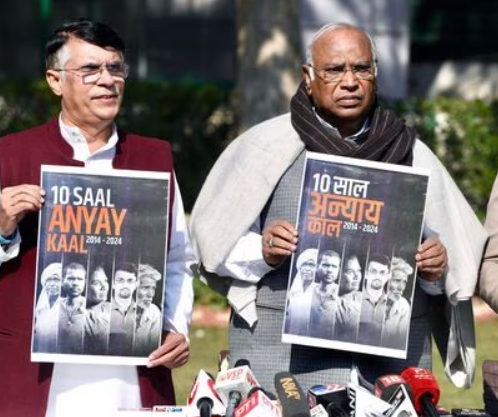White Paper vs Black Paper: Know the Key Differences in Detail
By Lokmat English Desk | Published: February 8, 2024 06:07 PM2024-02-08T18:07:16+5:302024-02-08T18:27:04+5:30
On Thursday, amidst the political discourse in India, two significant documents took centre stage: the 'White Paper on Indian ...

White Paper vs Black Paper: Know the Key Differences in Detail
On Thursday, amidst the political discourse in India, two significant documents took centre stage: the 'White Paper on Indian Economy' presented by the Centre in Lok Sabha and the 'Black Paper' released by the main opposition party, Congress. Here's a breakdown of what these documents represent and their implications:
What Is White Paper?
A White Paper is an official government document designed to provide comprehensive insights into government policies, achievements, and critical issues. Typically presented in a white cover, it follows government protocols for transparent communication with the public. The White Paper on Indian Economy aims to illustrate, assess, and analyze the overall economic policy evolution of the Indian government. It highlights the achievements and policies introduced during the government's tenure, offering a detailed examination of the country's economic trajectory.
What Is Black Paper?
A Black Paper is not an official government document but is often released by opposition parties to critique and target the government's actions and policies. The Black Paper serves as a platform for opposition parties to highlight alleged failures and shortcomings of the ruling party. Congress released a 54-page document titled “10 Saal Anyay Kal” as its Black Paper, focusing on what it perceives as the failures of the Narendra Modi government. This document aims to underscore issues such as unemployment and economic mismanagement, which the opposition alleges are neglected by the government.The Congress party's "black paper" serves as a comprehensive critique of the Narendra Modi government, highlighting what it perceives as failures and injustices during the last decade.
Here's an overview of the key points covered in the 54-page document:
- Injustice and Rising Prices: The document asserts that the last 10 years have been marked by a sense of "injustice," with rising prices of essential commodities contributing to the economic burden on the common people. It criticizes the government's handling of inflationary pressures, which have adversely affected household budgets.
- Unemployment Crisis: Highlighting the pressing issue of unemployment, the black paper underscores the failure of the government to generate sufficient employment opportunities for the youth. It points to the lack of job creation initiatives and inadequate support for sectors crucial for employment generation.
- Subversion of Institutions: The document accuses the Modi government of undermining democratic institutions and eroding their independence. It raises concerns about alleged attempts to suppress dissent and stifle voices critical of the government, thereby jeopardizing the country's democratic fabric.
- Discrimination Against Non-BJP States: Another focal point of the black paper is the allegation of discrimination against states not ruled by the BJP. It contends that the central government has displayed bias in its treatment of non-BJP states, depriving them of equitable development opportunities and resources.
Finance Minister Nirmala Sitharaman introduced a 'White Paper' detailing economic mismanagement during the United Progressive Alliance (UPA) tenure in the Lok Sabha on Thursday.
Key Points from NDA Govt's White Paper:
- Economy was in crisis in 2014; White paper then would have set negative narrative, shaken confidence of investors.
- NDA govt armed with political and policy stability, took tough decisions for greater economic good, unlike its predecessor UPA.
- Rather than employing quick fixes, the NDA government undertook bold reforms, and built a sturdy superstructure.
- In last ten years, NDA govt successfully overcame challenges left behind by the previous UPA government.
- The banking crisis was one of the most important and infamous legacies of the UPA government.
- Every challenge of the pre-2014 era was overcome through NDA govt's economic management and governance.
- Economic management of Modi govt placed India on resolute path of sustained high growth.
- UPA inherited healthy economy but made it non-performing in 10 years.
- Gross Non-Performing Assets ratio in Public Sector banks rose from 7.8% in 2004 to 12.3% in 2013. Inflation raged between 2009 and 2014.
- Over a 5-year period from FY2010 to FY2014, the average annual inflation rate was in double digits. Between FY04 and FY14, average annual inflation was 8.2%.
According to media reports, tomorrow Congress will present a 'Black Paper' in Lok Sabha, in response to the 'White Paper' presented by the Central Government against the UPA Government.
Open in app
